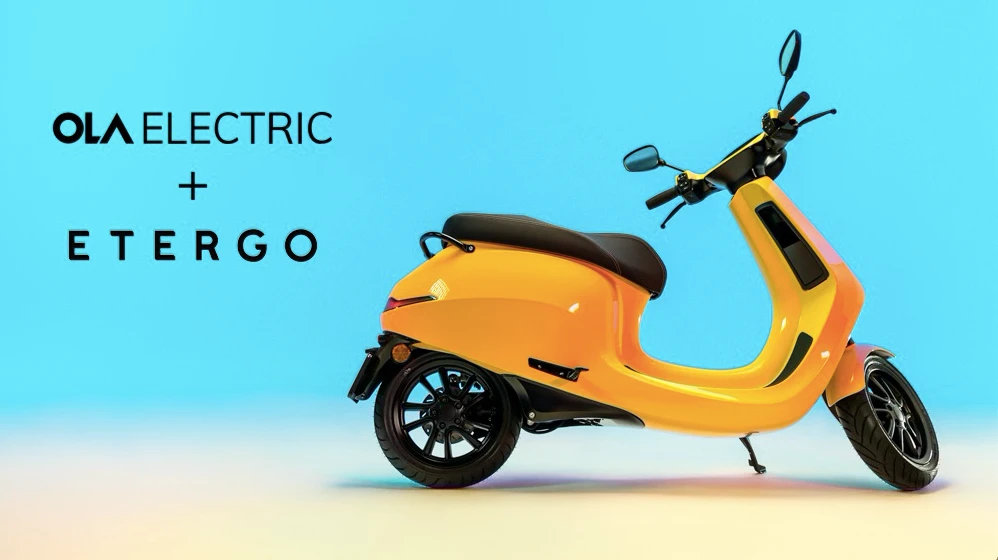Introduction:
The manufacturer of electric two-wheelers and supplier of sustainable transportation options is Ola Electric. Bengaluru serves as the company’s headquarters, and it was established in 2017. The business will shortly introduce its first item, an electric scooter, to the Indian market.
Ola Electric stands apart from other Indian mobility startups because it invests heavily in expanding its production capabilities from the start. In most cases, businesses start off small and gradually grow output in response to demand. However, Ola Electric made the decision to launch on a huge scale immediately away.
Although it looks hazardous, the mega-production plans could be advantageous in several respects. For instance, the business could profit from economies of scale. As a result, the business will be able to price its goods competitively when compared to those of competitors. A Rs 2,400 crore investment would build Tamil Nadu’s mammoth plant for Ola Electric. The plant will be able to produce 10 million units annually once it is finished.
Ola Electric Company Highlights:
| Company Name | Ola Electric |
| Headquarter | Bangalore, Karnataka, India |
| Industry | Cab/ Mobility |
| Founded | 2017 |
| Founder | Bhavish Aggarwal |
| Website | https://olaelectric.com/ |
Ola Electric About:
Ola Electric is India’s leading manufacturer of electric vehicles (EVs). Ola Electric aims to move the world to sustainable mobility advanced electric vehicles manufactured at its Futurefactory, the largest, most advanced, and sustainable two-wheeler factory in the world.
Ola Electric production facility will be the largest of its kind in the world. Spread across an area of 500 acres, the facility will have integrated manufacturing, battery production and supplier parks. The idea is to simplify logistics and increase localization to more than 90%. The plant will rely heavily on artificial intelligence (AI) and will have more than 3000 AI-based robots. This will ensure high level of quality and precision in manufactured products.
Ola Electric Industry:
Back in 2017, the founder noticed the immense possibilities that exist in electric two-wheeler space. The challenges were also apparent, for example, the high cost of electric two-wheelers and range anxiety. The lack of adequate charging infrastructure was another major factor that prevented users from switching to electric vehicles.
Ola electric scooters could potentially solve most of these problems. Along with a multi-million production capacity, the company is also building a large network of hypercharge stations across the country. Ola Hypercharger Network is being developed across 400 cities. In total, it will have more than 100 thousand charging points to begin with. Users can load 75 km in just 18 minutes. This hyper charger network will be crucial in eliminating range anxiety.
Ola Electric Founder & Team:

Ola Electric Founder (Image Source: gadgets360.com)
Ola Electric is led by Bhavish Aggarwal, who also heads Ola Cabs. Bhavish currently serves as the CEO of Ola Electric. He is a computer science graduate from IIT, Bombay. Prior to launching Ola Cabs, he had worked at Microsoft.
Ola Electric Mobility is an Indian electric two-wheeler manufacturer, based in Bengaluru, Karnataka, India. It is India’s largest electric two-wheeler manufacturer valued at around US$6 billion as of May 2023. It has a manufacturing facility located in Krishnagiri, Tamil Nadu which is India’s largest two-wheeler EV manufacturing factory.
Ola Electric Startup Story:
The early efforts to start Ola Electric started way back in 2017 when Ola partnered with the Government of India and Mahindra to launch India’s first-ever multi-modal electric vehicle project in Nagpur, Maharashtra.
Ola claimed that it had spent INR 50 crores to procure the vehicles and set up 50 charging stations across the strategic locations in the city. In 2019, Ola Electric Mobility secured funding of $250 million from Softbank and joined the unicorn club along with its parent company Ola.
2017-2019:
Ola Electric was established in 2017 as a wholly-owned subsidiary of ANI Technologies, the parent entity of Ola Cabs. The company was started to reduce emission and fuel dependency of Ola’s cabs, and shift to mass electric mobility; a pilot program was launched in Nagpur in May 2017 by setting up charging stations across the city and procuring electric cabs, e-buses, and e-rickshaws from OEM partners.
In December 2020, the company announced its plan to set up the world’s largest two-wheeler factory (called the Future Factory) in Tamil Nadu at a cost of ₹2,400 crore (US$300 million) after signing a memorandum with the Government of Tamil Nadu. It acquired a 500-acre land in Pochampalli, Krishnagiri District in January 2021; the construction work for the factory began in late February. Ola Electric received 500,000 bookings for scooters in the first month of availability.
Between December 2018 and January 2019, founder Bhavish Aggarwal bought a 92.5% stake in Ola Electric from ANI Technologies at a valuation of ₹1 lakh (US$1,300), and Ola Electric was spun off as a separate entity. ANI Technologies continued to hold a 7.5% stake in Ola Electric for allowing the use of “Ola” brand name.
In February 2019, Ola Electric raised US$56 million from Tiger Global and Matrix India. The company announced on 6 May 2019 that Ratan Tata had invested an undisclosed amount in Ola Electric as part of its Series A round of funding. It raised $250 million from SoftBank during Series B round funding in July 2019, at a valuation of over $1 billion.
2020-present:
Ola Electric acquired Amsterdam-based electric scooter manufacturer Etergo in May 2020 and announced that it would launch its own line of electric scooters in India by 2021.
To advance strides in the electric mobility space, Ola acquired Etergo BV, an Amsterdam-based electric scooter original equipment manufacturer, for an undisclosed amount. Following the acquisition, Ola has positioned itself in the premium electric two-wheeler market, both globally and locally
Ola Electric Mission & Vision:
At the heart of Ola Electric is vision to reduce global emissions and fossil fuel dependency by making India the epic centre of electrification. For this to become a reality, we aim to not just make electric vehicles but engineer a change in the mindsets of every Indian, a change that powers the vision behind Mission Electric.
Ola Electric Business Model:
business model of OLA Electric is Vehicle as a Service – Online-first companies offering electric vehicle sharing and rental services resulting in increased adoption of electric vehicles.
Ola Electric provider of electric-vehicle ride-hailing platform. It is being conducted by Ola to provide rides using electric cabs, buses, and rickshaw fleets. They are collaborating with EV and battery manufacturers, cities, and driver-partners. They plan to install swappable battery stations for the recharging of their vehicles.
Ola Electric Products & Services:
Currently, it offers an electric scooter named Ola S1 in three variants named Ola S1 Air, Ola S1, and S1 Pro. It plans to launch electric motorcycles by 2023 and an electric car by the end of 2024.
Ola Electric Funding & Investors:

Ola Electric (Image Source: olacabs.com)
Ola Electric is a well-funded organization with multi-million dollar investments. It is among the companies that have achieved the ‘Unicorn’ tag in the fastest possible time. Some of Ola Electric’s key investors include SoftBank Group, Tiger Global Management, Matrix Partners India, RNT Associates, Hyundai, Kia and Bank of Baroda.
Ola Electric raised more than $200 million from Falcon Edge, SoftBank Group and others at a valuation of $3 billion in September 2021. In December the same year, it raised $53 million in an investment round led by Singaporean holding company, Temasek. In January 2022, Ola Electric raised US$200 million from multiple investors at a valuation of US$5 billion.
Ola Electric raised $200 million in January last year from investors such as Tekne Private Ventures, Alpine Opportunity Fund, Edelweiss. Bengaluru-based electric-vehicle start-up Ola Electric has raised $300 million in its latest funding round as per a business outlet.
Ola Electric Employees:
It has 500-1000 employees.
Ola Electric Challenges Faced:
India’s largest e-scooter maker Ola Electric recorded an operating loss of $136 million on revenue of $335 million in the last financial year which concluded in March, three sources told Reuters, missing its publicly disclosed revenue goal.
In the wake of fire incident in their product in Pune on 26th March, the company recalled a batch of 1441 scooters in April. Claiming it as a pre-emptive measure the company said it will help them investigate further.
Ola Electric Acquisitions:
Ola Electric Mobility Pvt Ltd, the electric vehicle arm of Ola, has acquired Amsterdam-based Etergo BV.
Ola Electric Growth:
Executives at Ola Electric would have rejoiced at the spectacle of the company dethroning segment leader and one of its oldest incumbents, Hero Electric, for the pole position in India’s most lucrative mobility space — electric two-wheelers. Even as the traditional internal combustion engine (ICE)-powered two-wheeler market has alarmingly declined, the electric two-wheeler market has spurted at an eye-watering pace, even though on a low base.
Ola Electric sold 12,691 vehicles in April — overpowering the oldest incumbent, Hero Electric, which sold 6,572 vehicles. Okinawa Autotech was the second-highest-selling brand in the segment — clocking in sales of 11,012 vehicles.
Bhavish Aggarwal, the head honcho and the face of Ola Electric, known to not mince words, took to Twitter to celebrate the feat. We’re shaking up the incumbents and vested interests. They better focus on their products rather than fake narratives against us! Customers and markets have voted for facts and truth. We’re just getting started, reads his tweet.
Ola Electric’s market share grew by 39% when compared to March. It may be noted that Ola Electric has been able to dethrone the incumbents within five months of launching its scooter in the market. What makes the achievement an epochal moment for the Bengaluru-based company is that recently, it was fending off brickbats to protect its credibility to drive India’s electric mobility story.
The strongest arrow in Ola Electric’s quiver remains its Futurefactory. A sprawling, integrated manufacturing facility, it has enabled the company, according to Aggarwal’s own testimony, to manufacture around 1,000 scooters every day.
He also disclosed in a recent media engagement that the company has produced more than 50,000 scooters so far. It is also ramping up production to an envisaged capacity of 10 million units annually — spread across 100 acres, and it will also ensure over 90% of parts are localized and in close proximity.
Ola Electric Partners:
In late March 2022, Ola made a strategic multi-million-dollar investment in Israel-based battery technologies company StoreDot to incorporate and manufacture its XFC (extreme fast charging) battery technologies for future vehicles in India.
On 20 June 2022, Ola Electric teased its first sedan electric car, under development and likely to be launched in 2023. Company’s CEO Bhavish Aggarwal said that more details will be revealed on August 15 this year.
Ola Electric Competitors:
Ola Electric competes with other electric two-wheelers manufacturers such as Ather, Hero Electric, Ampere, Bajaj, Okinawa, and TVS.
Ola Electric Awards & Achievements:
Ola S1 Is The Electric Scooter Of The Year. The Ola S1 fended off tough competition from the TVS iQube S, Vida V1 Pro and the Okinawa Okhi-90 to win the electric scooter of the year category. Ola Electric is India’s leading manufacturer of electric vehicles (EVs).
Ola Electric Future Plan:
The wheel of innovation never stops turning, and we’re not planning to anytime soon.
- Building India’s sportiest electric car.
- Building a 1GW battery power delivering grid services.
Bhavish Aggarwal announced its upcoming battery innovation center (BIC) in Bangalore, which will be Asia’s largest Cell R&D facility. Bhavesh Aggarwal said that the Battery Innovation Center will include more than 165 pieces of “unique and cutting-edge” ab equipment that will cover every component of a cell, making it one of Asia’s largest and most advanced cell research and development (R&D) facilities.
FAQs about Ola Electric:
What does Ola Electric do?
Developer of two-wheeler electric scooters. The company designs and develops S1, S1 air, and S1 pro model electric scooters with features like high-speed range, 8.5 kW motor range, and more. It develops scooters with AI-enabled robots that claim to offer sustainable and eco-friendly rides to users. The company is also developing electric cars and a battery.
When was Ola Electric founded?
It was founded on 2017.
Who is the founder of Ola Electric Corporation?
Bhavish Aggarwal founded ola electric.
Who is the CEO of Ola Electric Corporation?
Bhavish Aggarwal is the CEO ola electric.
Who are the main competitors of Ola Electric?
Ola Electric competes with other electric two-wheelers manufacturers such as Ather, Hero Electric, Ampere, Bajaj, Okinawa, and TVS.
Conclusion:
From a startup in Bangalore to a global brand operating on 3 different continents, Ola has carved itself a name by being India’s largest mobility platform and one of the world’s largest ride-hailing companies.

Sai Sandhya is Known for her expertise in Trending News and Startup News. She is passionate about bringing Startup Stories to life. Her proficiency in curating Listings and analyzing Case Studies adds exceptional value to the ever-evolving Business landscape.










